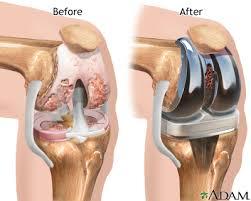Knee replacement surgery, also known as knee arthroplasty, is a common procedure for individuals suffering from severe knee arthritis or joint damage. The goal is to relieve pain, improve function, and enhance the overall quality of life. However, as with any major surgery, one of the most frequently asked questions is how painful the procedure is. In this post, we'll discuss the pain experienced before, during, and after knee replacement surgery, as well as the strategies used to manage discomfort.
Understanding the Surgery
Knee replacement surgery involves removing the damaged portions of the knee joint and replacing them with artificial components, typically made from metal and plastic. This procedure is recommended when conservative treatments such as physical therapy, medications, or injections fail to provide relief from knee pain and stiffness. While the surgery can significantly improve mobility and quality of life, it does come with its share of challenges, especially concerning pain.
Pain During the Procedure
It’s important to note that patients do not experience pain during the actual knee replacement surgery itself. The procedure is performed under general anesthesia, meaning the patient is completely unconscious, or regional anesthesia, where the lower half of the body is numbed. With the help of anesthesia, the patient remains pain-free throughout the surgery, which typically lasts between 1 to 2 hours.
In some cases, a nerve block is also used to numb the nerves in the knee area, providing additional pain relief after the procedure. This nerve block can last for several hours after surgery, helping to reduce the immediate discomfort once the anesthesia wears off.
Post-Surgery Pain: What to Expect
The pain experienced after knee replacement surgery varies from person to person, depending on factors like the individual’s pain tolerance, the extent of the surgery, and their overall health. However, it's important to remember that post-operative pain is a common part of the healing process.
Immediately following surgery, patients will experience some level of discomfort as the anesthesia wears off. The knee joint and surrounding tissues will be inflamed and sore due to the surgery. While this pain can be significant, hospitals and surgical centers have effective pain management strategies in place to ensure that patients are as comfortable as possible.
Pain Management Strategies
-
Medications:
Pain medications, including opioids, are typically prescribed during the initial days after surgery to manage pain. Non-steroidal anti-inflammatory drugs (NSAIDs) are also used to reduce inflammation. However, opioids are typically prescribed for a short period due to their potential for dependence and side effects. Your doctor will likely adjust the pain medication plan based on how well you're managing pain.
-
Physical Therapy:
A crucial part of recovery, physical therapy, may also contribute to discomfort in the early stages. Exercises designed to improve mobility and strengthen the knee may cause soreness, but this is essential for achieving long-term recovery and joint function. The pain from therapy is generally temporary and will gradually subside as the knee heals and gains strength.
-
Cold Compresses:
Ice packs or cold compresses can be very effective in reducing swelling and numbing the surgical area, providing much-needed relief in the first few weeks after surgery.
-
Elevation:
Keeping the leg elevated above heart level helps minimize swelling and discomfort. It’s an essential practice in the days following surgery.
-
Cryotherapy:
This involves applying cold therapy directly to the knee to help control pain and reduce inflammation.
-
Muscle Relaxants:
Sometimes, muscle spasms can accompany the recovery process, adding to the discomfort. Muscle relaxants may be prescribed to help relieve these spasms.
The Timeline of Pain
Immediately after surgery, pain levels are typically at their highest. For most patients, the first few days involve the most significant discomfort, but this can be well-managed with the right medication and interventions. By the end of the first week, many patients begin to notice improvements in their pain levels.
Over the next few weeks, as the swelling reduces and the knee begins to heal, pain should progressively decrease. By 3 to 6 months, the majority of patients report a significant reduction in pain, and many find that they are no longer experiencing the chronic discomfort that led to the surgery in the first place.
However, full recovery can take up to a year, and while the pain should continue to improve, some discomfort or soreness may persist during physical activities. It's important to remember that this pain is typically temporary and should gradually diminish as the knee becomes stronger and more flexible.
Factors Affecting Pain Levels
Several factors can affect the intensity and duration of pain following knee replacement surgery:
-
Age and Health:
Older patients or those with other health conditions may experience more pain or a slower recovery process.
-
Type of Surgery:
A total knee replacement (TKR) generally results in more pain compared to partial knee replacement (PKR), as the procedure is more invasive.
-
Patient Expectations:
Some patients may have higher pain thresholds or better coping mechanisms, while others may experience more intense discomfort.
Conclusion
Knee replacement surgery can certainly be painful, especially in the immediate days after the procedure. However, with effective pain management strategies, most patients find that the pain subsides over time, and the benefits of the surgery far outweigh the temporary discomfort. The pain during and after the surgery can be managed through medications, therapy, and other strategies, enabling patients to experience significant relief from chronic knee pain in the long run. Ultimately, while the pain of knee replacement surgery is real, it is temporary, and with proper care, the road to recovery can lead to a significant improvement in mobility and quality of life.
-
For More Other Treatment Below Link:-
https://www.edhacare.com/fa/blogs/top-ent-doctors-in-the-uae/
https://www.edhacare.com/fa/blogs/rhinoplasty-cost-in-dubai/
https://www.edhacare.com/it/hospitals/surgical-oncology-treatment-in-germany
https://www.edhacare.com/ka/treatments/cancer/anal-cancer
https://www.edhacare.com/mn/treatments/hepatology/pulmonary-fibrosis
https://www.edhacare.com/hy/treatments/gynecology/cervical-biopsy
https://www.edhacare.com/ta/hospitals/chennai-india
https://www.edhacare.com/gu/hospitals/ahmedabad-india
https://www.edhacare.com/bn/treatments/cancer/brain-cancer-treatment
https://www.edhacare.com/blogs/top-oncologists-in-uae/
https://www.edhacare.com/ms/treatments/ophthalmology/laser-surgery
https://www.edhacare.com/lt/treatments/cancer/blood
https://www.edhacare.com/doctors/gastroenterology-treatment-in-kims-hospital-in-bhubaneswar
https://www.edhacare.com/af/blogs/what-is-psoriasis-autoimmune-disease/
https://www.edhacare.com/sq/treatments/cancer/head-and-neck-cancer
